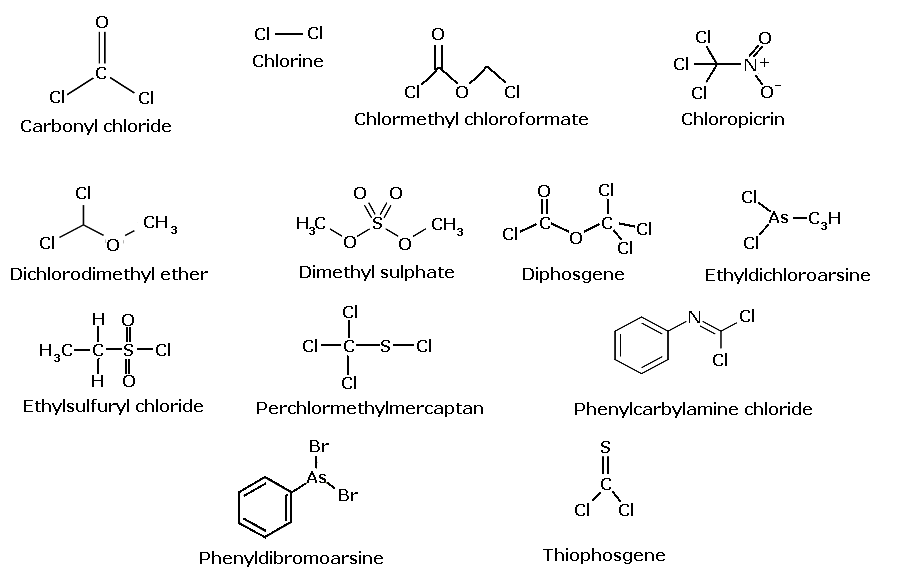Choking agents (aka Pulmonary agents as they irritate the lungs)
Choking agents were employed first by the German army and later by the Allied forces in World War I. The first massive use of chemical weapons in that conflict came when the Germans released chlorine gas from thousands of cylinders along a 6-km (4-mile) front at Ypres, Belgium, on April 22, 1915, creating a wind-borne chemical cloud that opened a major breach in the lines of the unprepared French and Algerian units. Eventually both sides mastered the new techniques of using choking agents such as chlorine, phosgene, diphosgene, chloropicrin, ethyldichlorarsine and perfluoroisobutylene, and launched numerous attacks though without any militarily significant breakthroughs once each side had introduced the first crude gas masks and other protective measures.Choking agents are delivered as gas clouds to the target area, where individuals become casualties through inhalation of the vapour. The toxic agent causes inflammation of the lungs and this causes fluids to build up in the lungs, which can cause death through asphyxiation. The effects may take up to three hours to be apparent. The long-term effects may last for many years.
Choking agents are not generally likely to be used in conventional warfare, but due to their ease of manufacture some have been used in recent years by countries that are not regarded as technologically advanced, and could also be used by terrorists.
Carbonyl
chloride [CG, Phosgene] - COCl2
One of very few choking agents that are considered likely to be used in warfare today. It is a colourless gas; in low concentrations, its odour resembles freshly cut hay or grass. Poisoning caused by phosgene depends on the amount a person is exposed to, the route of exposure, and the length of time that a person is exposed. Carbonyl chloride gas and liquid are irritants that can damage the skin, eyes, nose, throat, and lungs
Chlorine [Bertholite,
Red Star, Chlor] - Cl2
Chlorine gas can be recognized by its pungent, irritating odour, it smells like bleach which contains high concentrations of chlorine. The strong smell may provide adequate warning to people that they are exposed. Chlorine gas is yellow-green in colour. When it comes into contact with moist tissues such as the eyes, throat, and lungs, an acid is produced that can damage these tissues.
Chlormethyl
chloroformate [Palite, K-stoff, C-Stoff] -
ClCOOCH2Cl
Chloromethyl chloroformate appears as a colourless liquid at normal temperatures with a penetrating, irritating odor. It is denser than water. It is toxic by ingestion, inhalation and skin absorption. Inhalation, ingestion or contact (skin, eyes) with vapour or liquid may cause severe injury, burns or death. When it comes into contact with moist tissues such as the eyes, throat, and lungs, an acid is produced that can damage these tissues.
Chloropicrin [Nitrochloroform,
Aquinite, PS, NC, Klop, vomiting gas] - CCl3NO2
A colorless to faintly yellow oily liquid, which vapourises readily. It has an intensely irritating odour. Inhalation of 1 ppm causes eye irritation and can warn of exposure.
Dichlorodimethyl
ether & dibromodimethyl
ether ("Labyrinthic substances" - also
have a peculiar action on the ear labrynth affecting balance) -
(CH2Cl)2O & (CH2Br)2O
Both compounds have a suffocating and irritating odour. When they come into contact with moist tissues such as the eyes, throat, and lungs, formaldehyde and hydrochloric acid are produced that can damage these tissues. Severe eye damage can occur at very low levels of exposure, below those detectable by the sense of smell.
Dimethyl
sulphate [Rationite, D-Stoff] - (CH3)2SO4
Dimethyl sulphate is a colourless oily liquid with a slight onion-like odour (although smelling it would represent significant exposure). Dimethyl sulfate is absorbed through the skin, mucous membranes, and gastrointestinal tract, and can cause a fatal delayed respiratory tract reaction. Dimethyl sulphate can produce a lethal concentration in air by evaporation at 20°C.
Diphosgene
[DP,Trichloromethylchloroformate, Surpalite, Superpalite,
Perstoff] - ClCOOCCl3
Diphosgene is liquid at normal temperatures but readily produces vapour at toxic concentrations. It can be absorbed into the body in hazardous amounts by inhalation, it is not readily absorbed through the skin.
Ethyldichloroarsine [Dick,
EDED, TL-214; Dichloroethylarsine, Ethyldichloroarsine,
dichloro(ethyl)arsane, Ethylarsenic dichloride, Ethylarsonous
dichloride] - C2H5AsCl2
This colourless volatile liquid, reportedly smells like rotting fruit. Vapours irritate eyes and skin. Very toxic by inhalation. Denser than water and vapours are heavier than air.
Ethylsulfuryl
chloride [Sulvanite, ethanesulfonyl
chloride, Ethylsulfuryl Chloride, 1-Ethanesulfonyl Chloride] ClSO3C2H5
A pale yellow corrosive liquid. More dense than water and insoluble in water. Very toxic by ingestion, inhalation, or skin absorption.
Perchlormethylmercaptan [Carbon
tetrachlorsulfide, Clairsite, Perchloromethyl mercaptan,
Trichloromethane sulfenyl chloride, Trichloromethyl sulfur
chloride] - SCCl4
A yellow oily liquid with an offensive odor. Very toxic by inhalation or skin absorption.
Phenylcarbylamine
chloride [Phenyl isocyanide chloride,
Phenylcarbylamine chloride, Phenyl isocyanide dichloride,
Phenylcarbonimidic dichloride, N-(Dichloromethylene)aniline] - C6H5CNCl2
An oily liquid with an onion-like odor. It is a lung irritant with lachrymatory effects.
Phenyldibromoarsine
[Dibromophenylarsine] - C6H5AsBr2
Causes skin and eye blistering. May cause respiratory irritation.
Thiophosgene [Lacrimite,
Carbonothioic dichloride, Thiocarbonyl dichloride, Thiocarbonyl
chloride] - CSCl2 -
An easily vapourisable red liquid. A severe eye irritant. May severely burn skin on contact. Very toxic by inhalation and by skin absorption.

